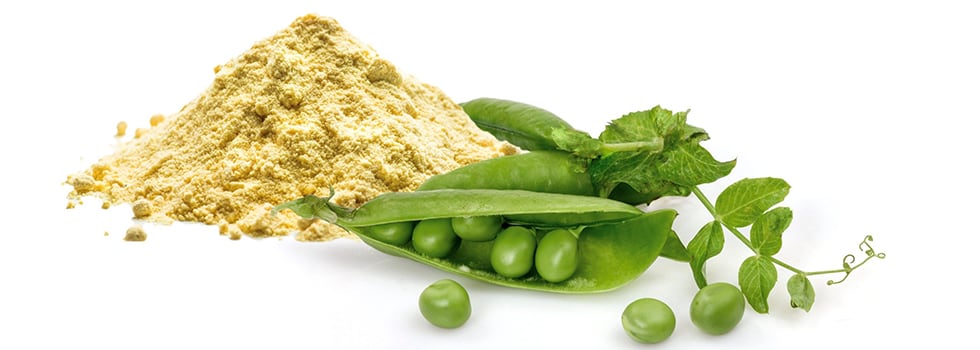Protein consumption is on the rise. From 2000 to 2018, global protein consumption increased by 40%.1
The trend presents opportunities for manufacturers but also places strains on supply and creates a need for alternative protein sources. Manufacturers that use alternative proteins stand to grow sales quickly but only if they can make products with desirable sensory properties.
To help manufacturers in Asia rise to the occasion and meet the challenge, Cargill has developed Radipure, a pea protein that is manufactured in Asia, for the Asian market. More importantly, Radipure is highly soluble and has a clean taste profile, areas that are important for many food and dairy applications.
Demographic changes in Asia have radically reshaped global demand for protein
Asia accounted for more than half of the increase in protein consumption from 2000 to 2018 as its population and income growth outstripped that of other parts of the world. In 1990, 21% of people in developing Asian countries were middle class or higher.2 By 2008, that figure had risen to 56%. The increased spending power of Asian consumers drove higher demand for protein.
“Demographic changes in Asia have radically reshaped global demand for protein. Today, a large, fast-growing number of people in Asia can afford to consume high-protein diets and are seeking out products that are rich in the macronutrient,” said Chik Liang, Segment Director, Cargill.
Forecast demographic changes in Asia suggest demand for protein will continue to rise. Almost 90% of the next 1bn entrants to the middle class are predicted to come from Asia.3 China and India are driving the trend alongside other Asian countries. A further 50m people in Indonesia, Malaysia, the Philippines, Thailand and Vietnam are forecast to join the middle class by 2022.4 The demographic shift will create a middle class across the five countries with $300bn of disposable income.
These demographic changes are predicted to help drive global per capital protein consumption up 27% between 2018 and 2025. Globally, one-third of consumers want to eat more protein.5 Two-thirds of people associate protein with “general health and wellness” and a significant minority link it to specific health benefits, such as improved energy levels and mental wellbeing.
Rising demand will necessitate a commensurate increase in supply. That could create challenges. Nonprofit WRAP said ensuring “a diversified, sustainable and healthy supply of protein will be one of the defining challenges of the coming decades.”6 WRAP’s statement reflects concerns that demand may outstrip supply, plus knowledge of the environmental impact of increasing meat production to cover the gap.
Plant-based proteins offer food manufacturers a way to meet rising demand. The authors of a 2017 study of protein supply and demand said plant-based proteins are “deemed to be preferable from a land use and [greenhouse gas] emission perspective.”7 That perception is contributing to increased interest in plant-based diets. A 2018 survey run in Hong Kong found almost one-quarter of people are flexitarian, up from closer to one-fifth two years earlier.8 Similar trends are evident in Australia, where manufacturers of plant-based products are reporting soaring sales.9
Manufacturers targeting these consumers need to continue creating products with desirable sensory properties. A survey of Malaysian consumers found taste is the second biggest driver of food and beverage purchasing decisions, second only to quality.10 The same survey found three-quarters of people want manufacturers to reformulate products to make them healthy, but only if the new formulation tastes at least as good as its predecessor.
Radipure: A pea protein for the Asian market
The significant opportunities and challenges related to high-protein products have led manufacturers to approach Cargill. The requests prompted Cargill’s R&D team to develop a pea protein product that meets the needs of manufacturers and consumers alike. The result is Radipure, a pea protein designed specially to meet the needs of the Asian market.
Radipure is more soluble than many plant-based proteins and low in beany flavor; characteristics that Cargill achieved through the use of a patented process and proprietary technology. Beany flavor is acceptable in some products but not for some other products. Manufacturers prefer a milder bean taste and they often combine it with chocolate and coffee to extend the breadth of their high-protein ranges.
By creating a highly soluble, clean-tasting protein, Cargill has given manufacturers more formulation flexibility, empowering them to incorporate Radipure into a wide range of high-protein products. The pea protein is suitable for use in dairy, ready-to-drink beverages, bakery and meat alternatives.
“We designed Radipure around the unique needs of the Asian market. With low-off taste, a pleasant mouthfeel and formulation flexibility, manufacturers can easily incorporate the protein into a wide range of products targeting Asian consumers,” said Chik Liang.
Radipure also meets other consumer demands. In making Radipure from peas, rather than other sources of plant-based protein, Cargill has created a product with low allergenic and label-friendly features. No commercial farmers are growing GMO peas.11 These facts have reached and resonated with some consumers, two-thirds of whom see pea protein as natural.12
Peas are also aligned with consumer concerns about sustainability. The production of peas requires less water and fertilizer than farming of other sources of plant-based protein.11 That partly reflects the ability of peas to fix nitrogen, which also means growing the crop can improve the health of the soil.13
The pea has positive health properties for growing children and adults too, particularly in Asia. Rice is a key source of protein in parts of Asia.14 However, rice is deficient in lysine, creating the risk that people, particularly children, will struggle to consume enough of the essential amino acid important for growth and key body and muscle functions. Adding pea protein to the diet mitigates that risk as the ingredient is rich in lysine.
The positive properties of peas have led Cargill to put the crop at the heart of its efforts to help food and beverage manufacturers meet fast-rising demand for sustainable, clean-label products that are rich in plant-based proteins. In the US, Cargill is working with PURIS to serve the market, while in Asia it has introduced its own brand Radipure. The upshot is manufacturers around the world can access the protein they need to meet health-focused consumer demands and thereby grow sales.
References
1. Protein Market: Size of the prize analysis for Australia. FIAL https://fial.com.au/Attachment?Action=Download&Attachment_id=200.
2. Special Chapter, the Rise of Asia’s Middle Class. in Key Indicators for Asia and the Pacific 2010 (Asian Development Bank, 2010).
3. Kharas, H. The unprecedented expansion of the global middle class. Brookings https://www.brookings.edu/research/the-unprecedented-expansion-of-the-global-middle-class-2/ (2017).
4. Understanding Southeast Asia’s Emerging Middle Class. Bain & Company https://www.bain.com/contentassets/9bde7ca6188446daa0259748c9b10886/bain__report_understanding_southeast_asias_emerging_middle_class.pdf.
5. Hughes, M. FMCG GURUS: Alternative protein sources: current and future market trends within the food, drink and nutritional supplement space. (2019).
6. Food Futures: From Business as Usual to Business Unusual. (2015).
7. Henchion, M., Hayes, M., Mullen, A. M., Fenelon, M. & Tiwari, B. Future Protein Supply and Demand: Strategies and Factors Influencing a Sustainable Equilibrium. Foods 6, (2017).
8. A Quarter of Hong Kong’s population practise flexitarian. Green Monday https://greenmonday.org/post/greenmonday-2018-survey-result/.
9. ‘Flexitarians’ driving soaring vegan food sales and quality. The Sydney Morning Herald https://www.smh.com.au/environment/sustainability/flexitarians-driving-soaring-vegan-food-sales-and-quality-20190409-p51chw.html (2019).
10. Healthier Product Reformulation in Malaysia. FIA https://foodindustry.asia/documentdownload.axd?documentresourceid=31379.
11. Zimberoff, L. The Rise of the Pea: How an Unassuming Legume Emerged as a Frontrunner in the Race to Replace Meat and Dairy. Time (2019).
12. Siegner, C. More than 50% of consumers have never heard of pea protein, survey finds. Food Dive https://www.fooddive.com/news/more-than-50-of-consumers-have-never-heard-of-pea-protein-survey-finds/564143/ (2019).
13. Miller, P. R. et al. Pea in Rotation with Wheat Reduced Uncertainty of Economic Returns in Southwest Montana. Agron. J. 107, 541–550 (2015).
14. FAOSTAT. http://www.fao.org/faostat/en/#data/CC.







